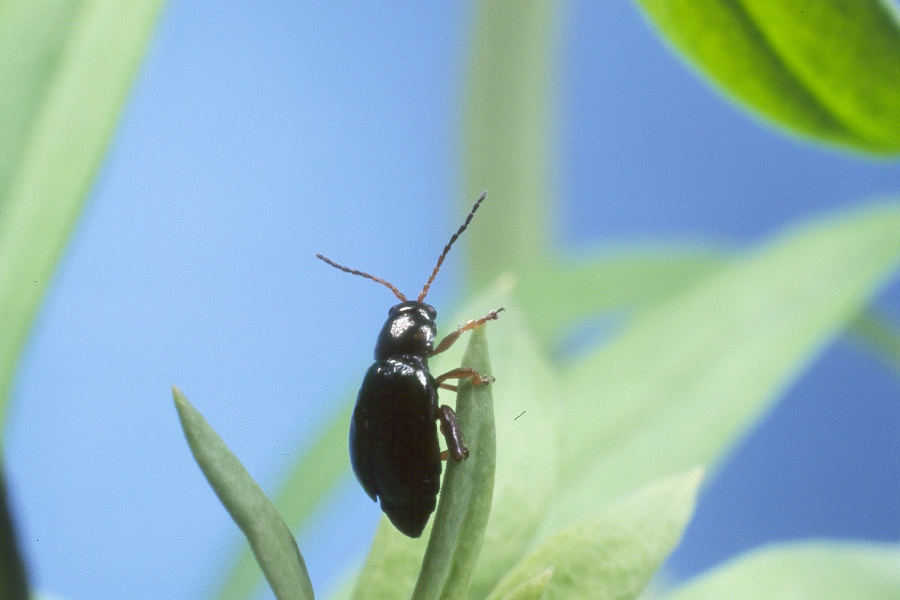-
Apthona laceratosa
Insect: Beetle, flea beetle (Coleopteran: Chrysomelidae)
Brown-legged leafy spurge flea beetle, black flea beetle
Photos: Adult 1 Adult 2

Photo by: Bob Richard, USDA-APHIS-PPQ.
Origin: Austria, Italy, the former Yugoslavia and eastern Hungary. (1)
Life cycle:
Over wintering stage: Larval (within the spurge roots). (1)
Egg stage: the eggs are deposited in small batches underground near the root of their host over a period of several months during the summer. (1)
Larval stage: Upon hatching, the larvae migrate to the root hairs and feed until the onset of cool fall temperatures and dormancy. Feeding begins again when the soil warms in the spring. (1)
Pupil stage: Pupation occurs within a soil cell from late spring to early summer. (1)
Adult stage: The adults emerge throughout the summer and feed on the leaves of leafy spurge. Each female produces 200 to 300 eggs. Adults are about 3 mm (0.12 in) long, black, and resemble A. czwalinae, except that the hind femora are brown. (1)
Effect:
Destructive stages: larval and adult. The larvae have the most damaging effects on spurge plants. (1,2)
Plant species attacked: Cypress spurge (Euphoria cyparissias), E. vibrate, with a lesser preference for E. lucid, E. steppes, and leafy spurge (E. esula). In laboratory studies, survival of this species was high on E. myrsinites and E. seguieriana. This specie does not survive outside the sub genus esula. (1)
Damage to host: As with the other flea beetle species, the beetles reduce the plant's root reserves and diminish its ability to replace them. Since the beetles are concentrated in the feeding areas, the effects are obvious. In low populations the affected plants are shorter and have delayed flowering periods. High concentrations of the beetles reduce plant density, or cause what often is referred to as "a hole in the spurge" patch (1)
Releases:
First introduced into the United States: North Dakota; Cleared for release in 1993.
Now established in: Montana, North Dakota, Oregon and Washington.
Habitat: Found in the steppe Biome of western Europe, mesic-dry to wet sites, with loamy soils and well developed herbaceous vegetation. Dry sites or flooded areas are considered unfavorable. (1)
Availability: Moderate, rapidly increasing (1,2)
Stage to transfer: Adult (1)
Redistribution: Collect the beetles from leafy spurge plants with a sweep net during the summer. The storage and shipping times are similar to those of apthona spa. Frozen roots and soil containing over wintering larvae can be dug from the field and kept frozen. The beetles can then be reared at room temperature. Sprinkle beetles In moderately dense leafy spurge infestations. Areas of high ant activity Should be avoided. (1)
Comments:
This species and A. czwalinae are the only two black flea beetles released for leafy spurge control. (1)
In host testing, this flea beetle readily accepted Canadian leafy spurge as strongly as as it did its native hosts. It has strong preference for E. virgata and its host range is limited to a few species in the subgenus Esula. Judging from its distribution in Europe, this species is anticipated to work in southern Canada and the northern part of the United States, but will not extend to the southern part in the United States. Like many of the other flea beetle species that attack leafy spurge, this species tends to congregate for feeding, mating, and egg-laying. (1)
After this species is released, leafy spurge plant density is greatly diminished at first. However, roots that are not attacked (including the taproot) are able to send up new shoots to supply the sugars for root reserves. It is only through the persistence of the beetles over a long period of time in ecosystems that favor beetle survival that the lateral roots of leafy spurge will be destroyed, the taproots weakened, and many of the plants eliminated from the area. (1) 'Though new to the Jefferson Co., MT area, these beetles are already showing large areas of damage at release sites on our spurge infestations. (2)
Bibliography
1. Rees, Norman, et, al., Ed., Biological Control of Weeds in the West, Western Society of Weed Science, in cooperation with USDA, ARS, MT Dept. of Ag, and MT State Univ., Bozeman, Color World Printers, Bozeman MT, Feb, 1996.
2. Breitenfeldt, Todd, Personal Interview, Whitehall Schools
science teacher. E-mail:
tbreit@whtlsv99.ixi.net, S-mail: mtwow.org: Whitehall Schools, P.O. Box 1109,
Whitehall, MT 59759, (406)287-3862.
By: Kyler Ward 1/7/02
mtwow.org HOME Back to Biological Control Agents, by Weed